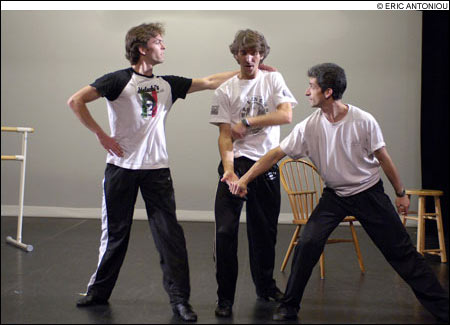Harvard University’s Music Department and the Office for the Arts celebrated Leonard Bernstein’s work last weekend with “Boston to Broadway,” a festive symposium surrounded by exhibitions and concerts. The wide-angle prospect of the event could have landed almost anywhere in the life of the musical prodigy who graduated cum laude from Harvard in the Class of 1939. The three symposium sessions I attended concentrated on two seminal theater works created by Bernstein and Jerome Robbins, Fancy Free (1944) and West Side Story (1957).

|
Fancy Free was Robbins’s first ballet and Bernstein’s first vernacular score. Immediately after its smash success at Ballet Theatre, the two young prodigies teamed up with Betty Comden and Adolph Green to create the Broadway show On the Town, with the same three sailors on shore leave in New York but a different plot. On the Town became a movie (Gene Kelly replaced Robbins as choreographer), and Bernstein later wrote another show and movie about rubes discovering New York, Wonderful Town, this one based on the novel My Sister Eileen.
The groundbreaking thing about Fancy Free was the way it made art out of everyday materials. This may seem perfectly obvious now, but 60 years ago ballet dancers were not supposed to resemble the boy next door. In Saturday morning’s lecture demonstration, New York City Ballet principal Damian Woetzel coached Jared Redick and Gabor Kapin of Boston Ballet through the opening scene of Fancy Free.
Attuned to the ballet’s fine detail as well as its depiction of a particular time and place, Woetzel pointed out the subtle postures that marked the different characters of the sailors, the instant switch between explosive tours en l’air and casual walking. He showed how every move in the ballet has a motivation and is tied to the music, even the sounds that are produced on stage, like handclaps and the shuffle of a time step.
ADVERTISEMENT
 |
“Probably no conductor ever danced on the podium as much as Bernstein,” said dance historian Lynn Garafola, introducing “Dancing the Story: Bernstein and his Choreographers,” a panel of experts and colleagues. In this session and the star-studded afternoon program “Revisiting the Original West Side Story on Stage and Film,” speaker after speaker confirmed Bernstein’s sensitivity to the physical expression of cultures and characters.
West Side Story carried American verisimilitude into darkness and violence, retelling Romeo and Juliet as a bitter New York morality play where street gangs fight over turf, girls, and race. Robbins directed and choreographed the show, which stunned Broadway with its powerful rhythms, songs, and dances of adolescent recklessness.
Bernstein’s theater work cast him in a different role from his alter ego as a celebrated, angst-racked composer who aspired to the creative eminence of a Stravinsky. In the theater his formidable charm and warmth made him a greatly appreciated collaborator, an antidote to the demanding, often cruel Robbins. According to Grover Dale, one of West Side Story’s original Jets, “Jerry gained strength by pointing out people’s weaknesses. Bernstein pointed out their strengths.” Carol Lawrence told hilarious stories about auditioning 13 times for the role of Maria; Marni Nixon, who dubbed Natalie Wood’s singing in the movie, revealed that Bernstein turned over part of his royalties to her.
Both Robbins and Bernstein authored theater works with other partners, and they embarked on things together that didn’t jell, but their collaborations on Fancy Free and West Side Story became legendary. I’d love to know more about Bernstein’s television opera, Trouble in Tahiti (1955), for instance, or his Mass (1971), which was choreographed by Alvin Ailey when Robbins withdrew. The other Robbins/Bernstein ballets, Facsimile, Age of Anxiety, and Dybbuk, were passed over lightly, and we didn’t hear much about Candide, either, or Bernstein’s movie scores, which included On the Waterfront. It was great to deepen my understanding of two mega-works, and I loved seeing the stars do their anecdotal numbers, but the symposium leaned heavily on celebrities and myths. Much more to come . . . somewhere.
In the Central Square studios over the weekend, two local choreographers showed the minimal side of things. Both sets of performances crammed a lot of material into the space of an hour. Nicole Pierce, director of EgoArt, called her concerts at Green Street “Dances Only,” explaining in pre-curtain remarks that this was the first all-dance program she’d ever tried. Having discovered quite a lot of dance material woven among previous attractions known for their use of gorilla suits, she decided to give her dance its own platform. The seven morsels suggested a choreographer capable of making some interesting musical choices (Pierce teaches piano as well as dance classes) and using them resourcefully. The dances — more like studies — used scraps of Schumann, Bach, Prokofiev, Gavin Bryars, and Elvis Costello, but Pierce was able to bring out some danceable possibility in each one.